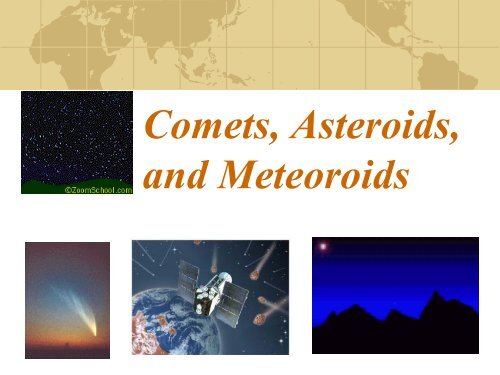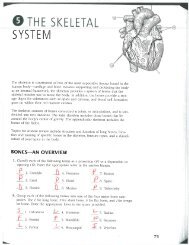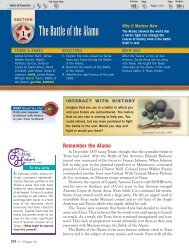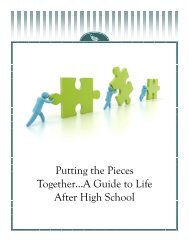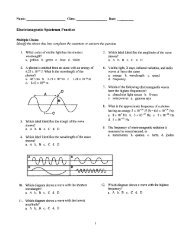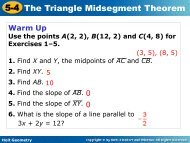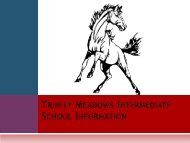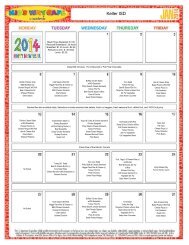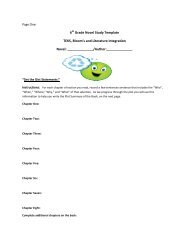Comets, Asteroids, and Meteoroids - Keller ISD Schools
Comets, Asteroids, and Meteoroids - Keller ISD Schools
Comets, Asteroids, and Meteoroids - Keller ISD Schools
Create successful ePaper yourself
Turn your PDF publications into a flip-book with our unique Google optimized e-Paper software.
<strong>Comets</strong>, <strong>Asteroids</strong>,<br />
<strong>and</strong> <strong>Meteoroids</strong>
1801<br />
Year Giuseppe Piazzi discovered the first<br />
asteroid, Ceres
4.6<br />
Earth years it takes the asteroid Ceres to travel<br />
around the sun (Ceres – Biggest Asteroid with a<br />
960 km circumference)
2880<br />
Year asteroid 1950 DA will pass close to Earth<br />
– The greatest known impact hazard
<strong>Asteroids</strong><br />
<strong>Asteroids</strong> are small, rocky worlds.<br />
Most asteroids revolve around the<br />
sun between the orbits of Mars<br />
<strong>and</strong> Jupiter. (asteroid belt)
<strong>Asteroids</strong><br />
Earth has been struck many<br />
times in its history by<br />
asteroids.
This 142-million-year-old<br />
crater has a diameter of almost<br />
fourteen miles (twenty-two<br />
km). Like many craters on<br />
Earth, it is misleading. The<br />
raised ring that is clearly<br />
visible to the left is not the<br />
crater rim. It is an erosional<br />
remnant. The remains of the<br />
actual rim are found farther<br />
out from the ring.
•100 km<br />
•212<br />
Million<br />
years old<br />
•Canada
What are they made of?<br />
Type<br />
Composition<br />
Percentage<br />
of <strong>Asteroids</strong><br />
Albedo<br />
(reflectivity)<br />
Carbon<br />
(C-type)<br />
Carbon<br />
over 75<br />
percent<br />
0.03-0.09 (Very<br />
dark)<br />
Silicate<br />
(S-type)<br />
Metallic iron mixed with ironsilicates<br />
<strong>and</strong> magnesium-silicates<br />
17 percent<br />
0.10 -0.22<br />
(Relatively<br />
bright)<br />
Metallic<br />
(M-type)<br />
Iron/ nickel<br />
less than 7<br />
percent<br />
0.10-0.18<br />
(Relatively<br />
bright)<br />
Dark (Dtype)<br />
Water ice/frozen carbon<br />
monoxide mixed with rock<br />
less than 1<br />
percent<br />
0.05 (Relatively<br />
dark <strong>and</strong> reddish)
Asteroid Ida <strong>and</strong> the tiny moon Dactyl
<strong>Comets</strong><br />
A comet is a<br />
“dirty snowball” about the<br />
size of an earth mountain.<br />
(dirt <strong>and</strong> ice)<br />
<strong>Comets</strong>’ orbits are<br />
usually very long, narrow<br />
ellipses.<br />
They produce tails of gas<br />
<strong>and</strong> dust when they<br />
approach the sun.
Halley’s Comet….<br />
Orbits every 76 years
Halley’s Comet Orbit…<br />
next seen in 2062
Oort Cloud
Comet: Hale-Bopp<br />
www.brainpop.com/science/space/comets/<br />
• Winter <strong>and</strong><br />
early spring of<br />
1997<br />
• Next sighting:<br />
4380
Deep Impact colliding with<br />
Temple1
Organic compounds
Meteoroid<br />
A meteoroid is a chunk of rock,<br />
metal, or dust in space.
A Meteor: “A shooting star”<br />
Shooting stars are<br />
not actually stars.<br />
These flashes of light<br />
across the sky are<br />
small bits of rock<br />
burning up in the<br />
Earth’s Atmosphere.
Meteorite<br />
<strong>Meteoroids</strong> that survive as they<br />
pass through the atmosphere<br />
<strong>and</strong> hit Earth’s surface are<br />
called meteorites.
http://www.meteorlab.com/METEORLAB2001dev/Open1.htm<br />
There are three major types of<br />
meteorites: stone, iron <strong>and</strong><br />
stony-iron.
Barringer Meteor Crater, Arizona<br />
A meteorite can make a hole, or crater, in<br />
the ground when it hits it. The larger the<br />
meteorite, the bigger the hole.
SUMMARY<br />
METEOROID: A piece of stone or metal<br />
that travels in outer space.<br />
METEOR: An object from space that<br />
becomes glowing hot when it passes into<br />
Earth's atmosphere.<br />
METEORITE: A piece of stone or metal<br />
from space that falls to Earth's surface.
Now do this<br />
In your journal, define Asteroid, Comet,<br />
Meteor, Meteoroid, <strong>and</strong> Meteorite.<br />
Compare <strong>and</strong> contrast all three using the<br />
Venn Diagram on the board.


